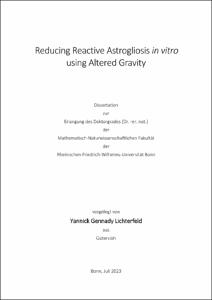Lichterfeld, Yannick Gennady: Reducing Reactive Astrogliosis in vitro using Altered Gravity. - Bonn, 2024. - Dissertation, Rheinische Friedrich-Wilhelms-Universität Bonn.
Online-Ausgabe in bonndoc: https://nbn-resolving.org/urn:nbn:de:hbz:5-74066
Online-Ausgabe in bonndoc: https://nbn-resolving.org/urn:nbn:de:hbz:5-74066
@phdthesis{handle:20.500.11811/11306,
urn: https://nbn-resolving.org/urn:nbn:de:hbz:5-74066,
doi: https://doi.org/10.48565/bonndoc-219,
author = {{Yannick Gennady Lichterfeld}},
title = {Reducing Reactive Astrogliosis in vitro using Altered Gravity},
school = {Rheinische Friedrich-Wilhelms-Universität Bonn},
year = 2024,
month = feb,
note = {Astrocytes are the prevalent type of glial cells in the brain and the whole central nervous system. In case of an injury or illness to the central nervous system (CNS), astrocytes in the surrounding tissue become reactive. Astrocytic reactivity is characterized by various complex phenotypic changes including hypertrophy, hyperproliferation, gene expression changes such as upregulation of GFAP (glial fibrillary acidic protein), and loss of clearly defined spatial astrocyte domains, connected to the migration of astrocytes to the region of injury. In case of severe trauma, the infiltration of astrocytes leads to reactive astrogliosis and ultimately to glial scarring. Reactive astrocytes form a scar-like barrier around the lesion by secreting a dense extracellular matrix and recruiting microglia and fibroblasts to prevent the intrusion of pathogens. Aside from these necessary functions to confine the injury, the glial scar negatively affects the regrowth of neuronal axons in the injured tissue leading to long-lasting obstruction of nerve fibers through the scar tissue, and in turn at worst case paralysis of patients.
In this thesis, altered mechanical loading achieved by hypergravity exposure on centrifuges or simulated microgravity on clinostats were evaluated as non-invasive methods to modify astrocyte behavior and reactivity. Primary murine cortical astrocytes were exposed to various gravity conditions and key parameters of astrocytic reactivity were investigated by biochemical assessment, live-cell, super-resolution and epifluorescence microscopy.
Hypergravity in the physiological range of 2g induced deficits in initial and long-term spreading of astrocytes with a reduction in cell area of app. 20-45%. Additionally, a reduction in migration velocities of astrocytes in a time-dependent manner was observed, indicating adaptive processes to hypergravity and readaptation to normal gravity. In parallel, STED microscopy revealed changes in the amount of cortical actin and less polarized lamellipodia as well as altered microtubule network polarization under hypergravity.
Cell proliferation and apoptosis under hypergravity were unchanged as compared to 1g controls. Interestingly, at the same time astrocyte reactivity marker protein expression was reduced, indicating that physiological hypergravity can be used to modulate reactivity in vitro. Cultivation in simulated microgravity reduced cell spreading by app. 20-30% accompanied by changes in morphological parameters. No changes in astrocyte reactivity, proliferation or microtubule network integrity were measured.
Altogether, altered gravity exposure is a promising method to modify cellular behavior in vitro, potentially leading to new avenues of therapy for patients to control astrocytic reactivity and ultimately glial scarring in vivo.},
url = {https://hdl.handle.net/20.500.11811/11306}
}
urn: https://nbn-resolving.org/urn:nbn:de:hbz:5-74066,
doi: https://doi.org/10.48565/bonndoc-219,
author = {{Yannick Gennady Lichterfeld}},
title = {Reducing Reactive Astrogliosis in vitro using Altered Gravity},
school = {Rheinische Friedrich-Wilhelms-Universität Bonn},
year = 2024,
month = feb,
note = {Astrocytes are the prevalent type of glial cells in the brain and the whole central nervous system. In case of an injury or illness to the central nervous system (CNS), astrocytes in the surrounding tissue become reactive. Astrocytic reactivity is characterized by various complex phenotypic changes including hypertrophy, hyperproliferation, gene expression changes such as upregulation of GFAP (glial fibrillary acidic protein), and loss of clearly defined spatial astrocyte domains, connected to the migration of astrocytes to the region of injury. In case of severe trauma, the infiltration of astrocytes leads to reactive astrogliosis and ultimately to glial scarring. Reactive astrocytes form a scar-like barrier around the lesion by secreting a dense extracellular matrix and recruiting microglia and fibroblasts to prevent the intrusion of pathogens. Aside from these necessary functions to confine the injury, the glial scar negatively affects the regrowth of neuronal axons in the injured tissue leading to long-lasting obstruction of nerve fibers through the scar tissue, and in turn at worst case paralysis of patients.
In this thesis, altered mechanical loading achieved by hypergravity exposure on centrifuges or simulated microgravity on clinostats were evaluated as non-invasive methods to modify astrocyte behavior and reactivity. Primary murine cortical astrocytes were exposed to various gravity conditions and key parameters of astrocytic reactivity were investigated by biochemical assessment, live-cell, super-resolution and epifluorescence microscopy.
Hypergravity in the physiological range of 2g induced deficits in initial and long-term spreading of astrocytes with a reduction in cell area of app. 20-45%. Additionally, a reduction in migration velocities of astrocytes in a time-dependent manner was observed, indicating adaptive processes to hypergravity and readaptation to normal gravity. In parallel, STED microscopy revealed changes in the amount of cortical actin and less polarized lamellipodia as well as altered microtubule network polarization under hypergravity.
Cell proliferation and apoptosis under hypergravity were unchanged as compared to 1g controls. Interestingly, at the same time astrocyte reactivity marker protein expression was reduced, indicating that physiological hypergravity can be used to modulate reactivity in vitro. Cultivation in simulated microgravity reduced cell spreading by app. 20-30% accompanied by changes in morphological parameters. No changes in astrocyte reactivity, proliferation or microtubule network integrity were measured.
Altogether, altered gravity exposure is a promising method to modify cellular behavior in vitro, potentially leading to new avenues of therapy for patients to control astrocytic reactivity and ultimately glial scarring in vivo.},
url = {https://hdl.handle.net/20.500.11811/11306}
}






